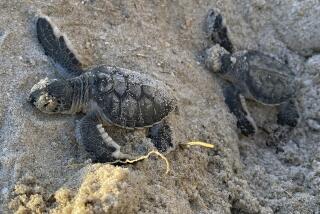Sea turtle finds her way back to birth beach, but how?
- Share via
It’s a sea turtle mystery that has stumped scientists for decades: How does the female sea turtle, which travels across thousands of miles of open ocean each year, still manage to navigate back to the same beach where she hatched to lay her eggs?
Keep in mind that there are no visual guideposts in the open ocean where sea turtles spend most of their lives. It is vast and featureless -- an expanse of blue. And yet every two to three years, sea turtles dig their nests at the same location where they once crawled out of their own leathery eggs -- a behavior known as natal homing.
Scientists have hypothesized that sea turtles may rely on information in the Earth’s geomagnetic field to help them find their way back to their birth beach, but they had never been able to find any evidence to support this hypothesis. Until now.
In a paper published Thursday in Current Biology, researchers show that subtle changes in the Earth’s magnetic field affect where loggerhead sea turtles bury their eggs on the Florida coast, providing the first clue that what’s known as the geomagnetic imprint hypothesis may be correct.
Since the mid-1990s, scientists have known that sea turtles are capable of deriving navigational information from the Earth’s geomagnetic field -- a field humans cannot sense without the use of scientific instruments.
The magnetic field around the Earth looks similar to the magnetic field around a bar magnet. Its intensity is strongest at the poles, and weakest at the equator. It also intersects the Earth at different angles, which are known as inclination angles.
“Turtles have evolved a way to use the inclination angle of the geomagnetic field, and its intensity, to give them almost an internal GPS,” said J. Roger Brothers, a graduate student at the University of North Carolina and the first author on the paper.
To see whether female turtles rely on this navigational tool to find their home beaches, Brothers and his advisor, UNC marine biologist Kenneth Lohmann, examined data collected over 19 years by the Florida Fish and Wildlife Conservation Commission on loggerhead nesting sites on the state’s Atlantic Coast, the largest sea turtle rookery in North America.
Because the Earth’s magnetic field is in constant flux, the researchers hypothesized that in years when the magnetic signatures of adjacent beaches moved closer together, there should be more nests on the same stretch of beach. In years when the magnetic signatures move farther apart, the nests should be more spread out.
That’s exactly what they found. At times and places where the magnetic signatures converged, scientists found an average increase of 35% in nesting density. At times when the signatures diverged, nesting density decreased by an average of 6%.
Nathan Putman, a research associate with the National Research Council who studies marine animal movement, said a turtle’s instinct to return to her home beach to nest is an evolutionary solution to a fundamental problem: How can you be sure your child will hatch in a safe place, find good foraging grounds, benefit from favorable current systems, and avoid being eaten by predators?
“What they hit on is you go back to the beach where you were hatched,” he said. “If it was good enough for you, it is good enough for your offspring.”
Putman said the study provides the strongest evidence to date for any of the hypotheses about how sea turtles return to their natal site.
“It is just a correlation but the statistics they have are robust,” he said. The probability that the changes in Earth’s magnetic signatures and the turtles’ nesting behavior are merely coincidental is “quite low,” he added.
David Godfrey, executive director of the Sea Turtle Conservancy in Gainesville, Fla., said that although the study makes a strong case, he believes other factors also come into play when sea turtles decide where to nest.
“Over the past 30 years in the state of Florida, there have been so many changes on the beach -- condo development, the introduction of artificial light everywhere, areas where erosion has been so bad that there is nothing but sea walls for miles,” he said. “So I wonder how the data can show, unequivocally, everywhere they look, the theory of geomagnetic navigation.”
Brothers and Lohmann do not suggest that the turtles are relying solely on a geomagnetic map to lay their eggs.
“We don’t expect that these turtles are coming to the magnetic signature regardless of what else is going on,” Brothers said. “If a condo is built there, they will usually decide to go nest somewhere else.”
There are other questions to be answered as well. For example, scientists are still not sure what mechanism the turtles are using to detect the geomagnetic field.
“Most likely they have tiny magnetic particles in their brains or in their bodies that act like a compass, but conclusive evidence is lacking,” Brothers said.
Lohmann said that part of the reason these magnetic receptors are so hard to find is that they may be scattered throughout the turtle.
“Whereas receptors for senses such as olfaction and vision must make contact with the external environment, magnetoreceptors might be located almost anywhere inside an animal’s body,” he explained in a News and Views article in the journal Nature in 2010.
Going forward, Brothers said he would like to see similar studies done on other animals that exhibit natal homing, perhaps salmon, sharks, migratory birds and elephant seals.
“Our hope is that this analysis will open the door to figuring out how all the other animals are doing it,” he said.
Science rules! Follow me @DeborahNetburn and “like” Los Angeles Times Science & Health on Facebook





